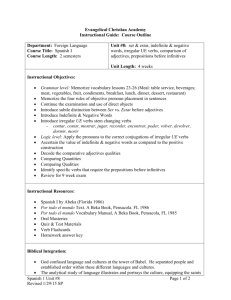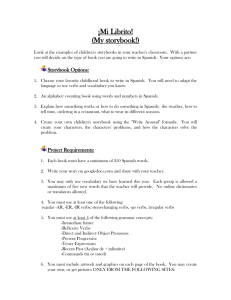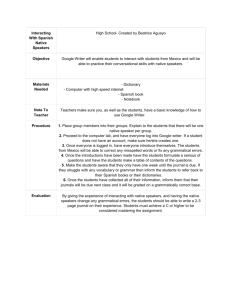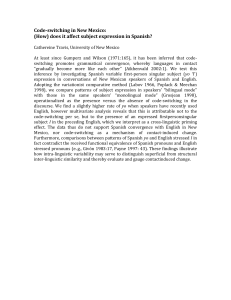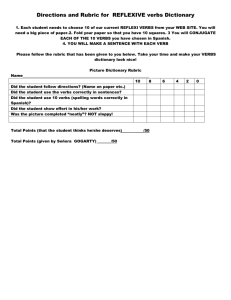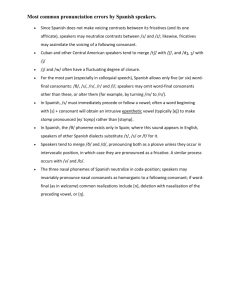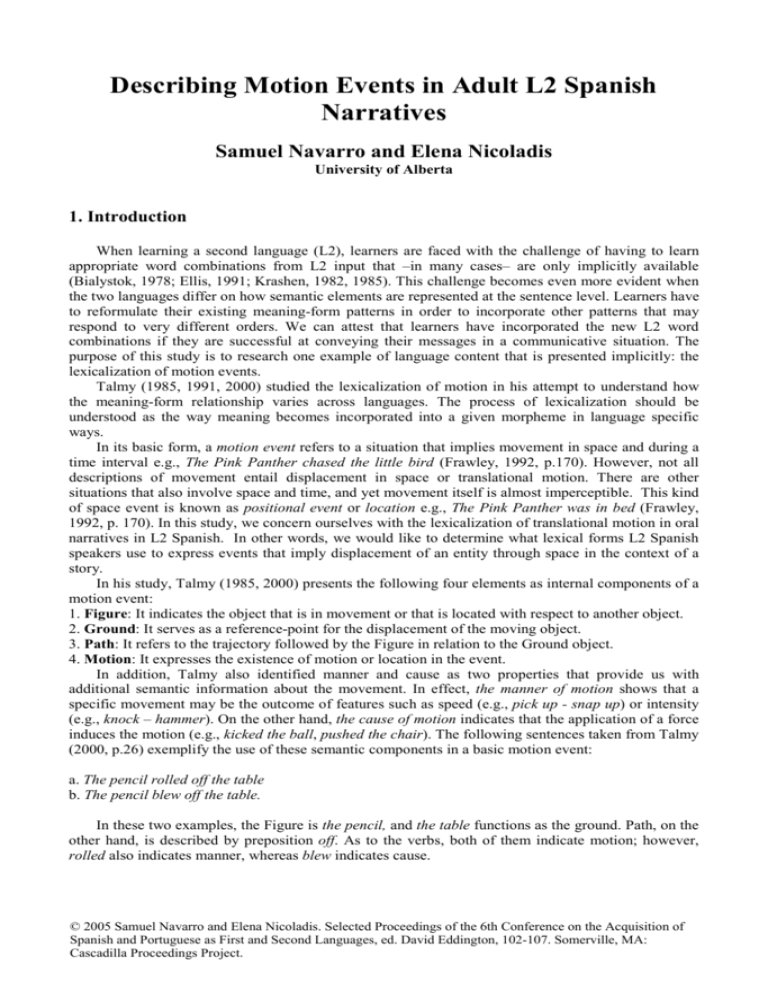
Describing Motion Events in Adult L2 Spanish
Narratives
Samuel Navarro and Elena Nicoladis
University of Alberta
1. Introduction
When learning a second language (L2), learners are faced with the challenge of having to learn
appropriate word combinations from L2 input that –in many cases– are only implicitly available
(Bialystok, 1978; Ellis, 1991; Krashen, 1982, 1985). This challenge becomes even more evident when
the two languages differ on how semantic elements are represented at the sentence level. Learners have
to reformulate their existing meaning-form patterns in order to incorporate other patterns that may
respond to very different orders. We can attest that learners have incorporated the new L2 word
combinations if they are successful at conveying their messages in a communicative situation. The
purpose of this study is to research one example of language content that is presented implicitly: the
lexicalization of motion events.
Talmy (1985, 1991, 2000) studied the lexicalization of motion in his attempt to understand how
the meaning-form relationship varies across languages. The process of lexicalization should be
understood as the way meaning becomes incorporated into a given morpheme in language specific
ways.
In its basic form, a motion event refers to a situation that implies movement in space and during a
time interval e.g., The Pink Panther chased the little bird (Frawley, 1992, p.170). However, not all
descriptions of movement entail displacement in space or translational motion. There are other
situations that also involve space and time, and yet movement itself is almost imperceptible. This kind
of space event is known as positional event or location e.g., The Pink Panther was in bed (Frawley,
1992, p. 170). In this study, we concern ourselves with the lexicalization of translational motion in oral
narratives in L2 Spanish. In other words, we would like to determine what lexical forms L2 Spanish
speakers use to express events that imply displacement of an entity through space in the context of a
story.
In his study, Talmy (1985, 2000) presents the following four elements as internal components of a
motion event:
1. Figure: It indicates the object that is in movement or that is located with respect to another object.
2. Ground: It serves as a reference-point for the displacement of the moving object.
3. Path: It refers to the trajectory followed by the Figure in relation to the Ground object.
4. Motion: It expresses the existence of motion or location in the event.
In addition, Talmy also identified manner and cause as two properties that provide us with
additional semantic information about the movement. In effect, the manner of motion shows that a
specific movement may be the outcome of features such as speed (e.g., pick up - snap up) or intensity
(e.g., knock – hammer). On the other hand, the cause of motion indicates that the application of a force
induces the motion (e.g., kicked the ball, pushed the chair). The following sentences taken from Talmy
(2000, p.26) exemplify the use of these semantic components in a basic motion event:
a. The pencil rolled off the table
b. The pencil blew off the table.
In these two examples, the Figure is the pencil, and the table functions as the ground. Path, on the
other hand, is described by preposition off. As to the verbs, both of them indicate motion; however,
rolled also indicates manner, whereas blew indicates cause.
© 2005 Samuel Navarro and Elena Nicoladis. Selected Proceedings of the 6th Conference on the Acquisition of
Spanish and Portuguese as First and Second Languages, ed. David Eddington, 102-107. Somerville, MA:
Cascadilla Proceedings Project.
103
2. Lexicalization of motion in English and Spanish
In his typological description, Talmy (1985, 2000) showed that a semantic category like motion
may be expressed in various lexico-syntactic sentence frames. He also demonstrated that speakers do
not randomly generate such frames; on the contrary, they respond to systematic patterns of each
language. In this context, Talmy presented English and Spanish as examples of languages whose
canonical frames for the expression of motion respond to different typologies. In effect, empirical
evidence has demonstrated that in spontaneous descriptions of motion scenes, English speakers favour
the use of intransitive verbs that conflate motion and manner or cause (e.g., The Pink Panther walked
to the bridge, The Pink Panther ran to the river). Path, on the other hand, is expressed by particles that
accompany the verb (e.g., up, down, out) and leave information about the location (the ground) to be
inferred (Berman & Slobin, 1994; Naigles, Eisenberg, Kako, Highter, & McGraw, 1998; Naigles &
Terraza, 1998; Özçalişkan & Slobin, 1999; Slobin, 1996, 2003; Talmy, 1985, 1991, 2000). While this
is a general tendency of English, note that speakers may also structure utterances with motion and path
conflated in the main verb (e.g., The Pink Panther left the house). Frawley (1992, p.178) argues that
the lexicalization of the manner of motion is common in colloquial English, though in formal speech
speakers tend to use more path verbs such as ascend, descend, enter, cross, etc.
Conversely, numerous studies on motion production in Spanish have shown that speakers’
descriptions of motional scenes largely conflate motion and path in verbs followed by prepositions a
(“to”), de (“from”), and para (“to/for/towards”) to indicate ground information (i.e., goal, source, or
location) e.g., La Pantera saltó del puente (“The Panther jumped from the bridge”). They also specify
the location of the figure using prepositional phrases e.g., en la calle (“on the street”) that may even
precede the motion event itself (Aske, 1989; Berman & Slobin, 1994; Özçalişkan & Slobin, 1999;
Slobin, 2003). On the other hand, manner appears as less salient to Spanish speakers and it is
optionally encoded in adverbials or gerundives e.g., salió corriendo (“exited flying”). While path
conflation is the general lexicalization pattern of the language, Spanish speakers certainly can conflate
motion and manner, namely in intransitive verbs (see Aske, 1989; Naigles, Einsenberg, Kako, Highter,
& McGraw, 1998; Slobin & Hoiting, 1994).
Regarding rhetorical style, Berman & Slobin (1994) indicated that Spanish narratives are rich in
ground information for setting up scenes. Many of these locative descriptions may even appear before
the motion event is described. As a result, Spanish speakers omit redundant post-verbal grounds,
yielding copious bare path verbs.
The literature on the description of motion events in English and Spanish is based mainly on
studies on the language production of children and adult monolingual speakers (for details, see Berman
& Slobin, 1994; Naigles, Einsenberg, Kako, Highter, & McGraw, 1998; Naigles & Terraza, 1998;
Özçalişkan & Slobin, 1999; Slobin & Hoiting, 1994; Slobin, 1996, 1997, 2003; Talmy, 1991). For the
most part, these studies have aimed at empirically validating Talmy’s proposal. Nevertheless, and to
the best of our knowledge, no previous study has investigated the lexicalization of motion events in
interlanguage. In this context, the present research is a first attempt to investigate crosslinguistic effect
in L1 English-L2 Spanish adult speakers for the typologically determined motion conflation patterns in
Spanish. We propose that the lexicalization of path ─understood as a systematic preference of
Spanish─ constitutes the most salient aspect of the motion event and native speakers acquire it as part
of their L1. We may wonder then what happens to learners of the Romance language whose L1
systematically induces them to stress other aspects of motion?
In this study, we attempt to shed some light on this issue by addressing the following research
questions: (1) To what extent do advanced L2 Spanish speakers build lexicalization patterns of motion
on the lexicalization patterns of their L1? (2) Does the process of learning to lexicalize motion in a
second language entail relearning to view motion scenes from the “perspective” that native speakers
consider is more salient?
3. Method
Participants. The participants in this study were ten L1 English-L2 adult proficient Spanish speakers
(6 females, 4 males), professors and students at the University of Alberta and college-educated
residents from Edmonton, Alberta, with a mean age of 36 years. As to their language training, all of
104
the participants had been enrolled as adult students in different Spanish programs at the post-secondary
level for more than two years. Moreover, all of them have had the opportunity to enhance their
language skills while visiting Spanish-speaking countries on different occasions and for various
lengths of time. In addition, there was a group of ten L1 adult Spanish speakers (6 females, 4 males),
mean age 34 years, made up of students at the University of Alberta and college-educated
professionals from Edmonton, Alberta. These participants came from various Spanish-speaking
countries.
Materials. The stimuli were two video excerpts from the Pink Panther cartoon (2 minutes each)
presented sequentially. The first story was about the Pink Panther struggling with a very determined
cuckoo clock that had been bought to help the Panther wake up in the morning. The second story
showed the Panther trying to control a jet plane that took on a life of its own and had the Panther at its
mercy. Although these stories were silent, they had a clear plot that was rich in temporal and causal
sequences, displacement from place to place, location, etc. We would like to stress the value of using
video films as stimuli for eliciting data. This technique enables participants to describe a motion scene
based on an actual dynamic figure that is in displacement within a given context. As a result,
participants have access to a more accurate and realistic observation that triggers a natural use of
motion frames. Previous studies of motion descriptions largely depended on picture stories. This kind
of stimuli yielded interesting results, though participants were faced with the challenge of having to
infer motion events from static images (Naigles et al., 1998).
Procedure. First, the participants were invited to watch the two video excerpts in a laboratory of the
Department of Psychology at the University of Alberta. They were then asked to tell the stories orally
in Spanish to a native speaker of Spanish. The oral narratives were conducted individually and video
taped.
Coding. All narratives were transcribed using CHAT (MacWhinney, 2000). Seventy percent of the
utterances produced by the participants had one main verb and we only considered the main verbs. We
coded verbs as manner or path using verb categorizations and examples available in the literature
(Naigles et al., 1998; p. 530; Özçalişkan & Slobin, 1999, p. 547; Slobin, 1996b, p. 198). For doubtful
cases or verbs that did not appear in previous categorizations, we prepared a list and asked five L1
Spanish speakers to classify them in two columns each of which contained a prototypical path-like and
manner-like example as a guide. Moreover, we coded the data for verb transitivity and presence or
absence of ground expressions.
4. Results and discussion
Our analysis of the data aimed to address the research questions which have motivated this study.
We present the results for each analysis separately: how L2 Spanish speakers encoded path verbs e.g.,
La Pantera Rosa fue sola; manner verbs e.g., La Pantera Rosa caminó sola; and adverbial
constructions e.g., hasta la casa.
4.1. Motion conflation patterns
Figure 1 shows the total number of manner and path verbs (both transitive and intransitive)
produced by the L2 and L1 Spanish speakers. As can be observed, L2 Spanish speakers used more
path conflation than manner conflation; however, this difference was not overwhelming. Across all
files, participants produced a mean of 22.00 path verbs (SD 13.32), and 10.00 manner verbs (SD 9.82).
Conversely, the L1 Spanish group clearly used more path conflation. Across all files, participants
produced a mean of 34.20 path verbs (SD 8.50), and 8.50 manner verbs (SD 2.72).
105
40
35
30
25
20
15
10
5
0
Path
Manner
Path
L2 Spanish
Manner
L1 Spanish
FIG.1. Mean number of path and manner conflation by speaker group.
We compared the two groups for their percent use of path conflation. The two groups differed in
the number of verbs they used, so we performed this calculation on the percentage of path conflation
each person used. That is, we calculated the percentage of path verbs out of the path + manner verbs
used by each participant. The results showed that from the 316 L2 Spanish motion verbs, 69% were
path verbs (mean 71%, SD 16%). The L1 Spanish group, on the other hand, produced 427 motion
verbs and 80% were path verbs (mean 81%, SD 6%). A two-tailed independent samples T-test
indicated that the difference in path verb use between the two groups was not significant (t (18) = 1.83,
P < 0.08). Put differently, the L1 Spanish speakers did not produce significantly more path conflation
than the L2 speakers.
4.2. Motion verb transitivity and complement use
As mentioned earlier, Spanish speakers preferably conflate motion and path in verbs followed by
different kinds of prepositional phrases (Aske, 1989; Özçalişkan & Slobin, 1999; Slobin, 2003). In
order to verify whether our L2 data conform to these patterns of Spanish, we decided to investigate the
percent use of transitive and intransitive path verbs and the kind of post-verbal phrase, whenever there
was one. From the 220 L2 path verbs 184 were intransitive (84%) and 36 were transitive (16%).
Similarly, the L1 speakers produced 342 path forms, 302 were intransitive (88%) and 40 were
transitive (12%). In sum, our results showed that both language groups clearly preferred conflating
path in intransitive verbs. Our next analysis shows the percentage of post-verbal structures produced
by the two groups of speakers. In this paper, we are only reporting on adverbial phrases accompanying
path intransitive verbs.
Figure 2 below shows that from the 184 L2 path intransitive verbs, 160 (87%) were followed by
an adverbial construction, whereas 24 were bare path verbs (13%). In other words, whenever the L2
speakers used intransitive path verbs, they were also ready to provide additional information about the
figure using a descriptive phrase. The 302 L1 intransitive path verbs were divided into 235 forms with
a post-verbal phrase (78%) and 67 as bare path verbs (22%). Although the L1 group had more verbs
with some kind of post-verbal structure, they resorted to bare forms more than the L2 group. A twotailed independent-samples t test confirmed that L1 speakers used bare path verbs significantly more
than L2 speakers (t (18)= 2.75, P < 0.02). This result seems to suggest that the L2 Spanish speakers
have not fully acquired the use of bare verbs as a property of Spanish rhetorical style. On the contrary,
they mostly opted for the English pattern of producing intransitive verbs followed by a phrase (Berman
& Slobin, 1994; Talmy, 1991).
106
1 00
80
60
40
20
0
Adverbials
L2 Spanish
Bare verbs
Adverbials
L1 Spanish
Bare verbs
FIG. 2. Percent of intransitive path verbs with adverbial phrases and bare verbs divided by speaker
groups.
A further analysis of the types of post-verbal constructions revealed that from the 160 L2
structures produced, 84 of them (53%) were phrases introduced by prepositions a, de, and para to
express ground information. Moreover, 76 phrases (47.%) were adverbials and gerundives functioning
as manner expressions. These results for the L2 group are congruent with Aske’s (1989) claim that
most path ground phrases serve to indicate the goal, source or location in Spanish. In contrast to
Aske’s findings, from the 235 L1 post-verbal structures only 99 of them (42%) indicated ground
information and 136 (58%) functioned as manner expressions. These results support the notion that L1
Spanish speakers convey manner in adjunct expressions instead of verbal conflation (Naigles et al.,
1998).
5. General discussion
In this study, we investigated the lexicalization of motion events in the oral narratives of L1
English-L2 Spanish adult speakers. Following Talmy (1985, 2000), English and Spanish present
different conflation patterns for motion events. This difference makes it interesting to explore whether
advanced L2 Spanish speakers lexicalize motion events following their L1 patterns and also whether
L2 speakers learn to view the motion scenes in the same way as native speakers, that is to say, by
focusing on aspects that native speakers find most salient. Our analyses showed that the L2 Spanish
speakers have almost fully achieved the L1 Spanish pattern for the description of motion events in oral
narratives. They clearly described the video excerpts stressing the most salient aspect of motion in
Spanish: path. As shown above, 69% of the 316 L2 verbs produced were path and 84% of these verbs
were intransitive.
It was also observed that L2 speakers, more than L1 speakers, produced path intransitive verbs
followed by a post-verbal phrase and this result was interpreted as a possible influence of English on
the L2 narratives. L1 speakers, on the other hand, resorted more to bare path intransitive verbs in
agreement with the Spanish rhetorical style (Berman & Slobin, 1994). An analysis of the L2 postverbal phrases was congruent with previous findings that indicated that L1 Spanish speakers use these
structures to describe the source, goal, or location. While the L2 speakers produced fewer post-verbal
manner expressions than the L1 group, our results confirmed that they compensated for this difference
by producing more manner verbs. Curiously enough, L1 speakers showed just the opposite patterns.
They produced fewer manner verbs, but they balanced this by including a larger number of post-verbal
adverbials and gerundives.
In sum, our results have demonstrated that even though there are still some traces of English in
these L2 Spanish narratives, these speakers present a clear trend towards a complete acquisition of the
Spanish typology. This observation is particularly relevant if we consider that motion verbs are not
formally presented as part of the L2 Spanish language curriculum. Thus, L2 learners are implicitly
exposed to this kind of input while communicating with their language instructors or native speakers in
naturalistic situations. Notice that motion or the idea of figures in motion is a recurrent topic in human
communication (Talmy, 1985, 2000). Therefore, L2 learners have multiple possibilities of negotiating
107
meaning that involves movement or its description. As a result, the L2 meaning becomes transparent
and comprehensible for the learners. This, in turn, enables them to notice and naturally acquire the
syntactic mapping which conveys this meaning at the sentence level (Krashen, 1982, 1985; Schmidt,
1990, 1993; Van Patten, 1989, 1990).
The present study has given clear evidence of an acquisition process that entails a substantial
reformulation of the meaning-in-form language pattern (Talmy, 2000). These findings have also
opened up grounds for future research that will provide us with further evidence of how and when,
over the course of acquisition, L2 Spanish learners incorporate the L1 Spanish syntactic mapping for
the expression of verbs of motion.
References
Aske, J. (1989). Path predicates in English and Spanish: A closer look. Proceedings of the Berkeley Linguistics
Society, 15, 1-14.
Berman, R. A., & Slobin, D. I. (1994). Relating events in narrative: A crosslinguistic developmental study.
Hillsdale, NJ: Erlbaum.
Bialystok, E. (1978). A theoretical model of second language learning. Language Learning, 28, 69-84.
Frawley, W. (1992). Linguistic semantics. Hillsdale, NJ: Earlbaum.
Krashen, S. (1982). Principles and practices in second language acquisition. London: Pergamon.
Krashen, S. (1985). The input hypothesis: Issues and implications. New York: Longman.
MacWhinney, B. (2000). The CHILDES Project. Mahwah, NJ: Erlbaum.
Naigles, L. R., Eisenberg, A. R., Kako, E. T., Highter, M., & McGraw, N. (1998). Speaking of
motion: Verb
use in English and Spanish. Language and Cognition Processes, 13, 521-549.
Naigles, L.R. & Terrazas, P. (1998). Motion verb generalizations in English and Spanish: Influences of language
and syntax. Psychological Science, 9, 363-369.
Özçalişkan, S. & Slobin, D. I. (1999). Learning how to search for the frog: Expression of manner of motion in
English, Spanish, and Turkish. In A. Greenhill, H. Littlefield, & C. Tano (Eds.), Proceedings of the 23rd
Annual Boston University Conference on Language Development: Vol. 2 (pp. 541-552). Somerville, MA:
Cascadilla Press.
Schmidt, R. (1990). The role of consciousness in second language learning. Applied Linguistics, 11, 129-158.
Schmidt, R. (1993). Awareness and second language acquisition. Annual Review of Applied Linguistics, 13, 206226.
Slobin, D. I. (1996). Two ways to travel: Verbs of motion in English and Spanish. In M. Shibatani & S. A.
Thompson (Eds.), Grammatical constructions: Their form and meaning (pp. 195-220). Oxford: Clarendon
Press.
Slobin, D. I. (1997). Mind, code, and text. In J. Bybee, J. Haiman, & S. A. Thompson (Eds.), Essays
on
language function and language type: Dedicated to T. Givón (pp. 437-467).
Slobin, D. I. (2003). The many ways to search for a frog: Linguistic Typology and the expression of motion
events. In S. Strömqvist & L. Verhoeven (Eds.), Relating events in narrative: Typological and contextual
perspectives. Mahwah, NJ: Erlbaum.
Slobin, D.I., & Hoiting, N. (1994). Reference to movement in spoken and signed language: Typological
considerations. In Proceedings of the Berkeley Linguistic Society, pp. 487-505. Berkeley: Berkeley
Linguistics Society.
Talmy, L. (1985). Lexicalization patterns: Semantic structure in lexical forms. In T. Shoepen (Ed.), Language
typology and lexical description: Vol. 3. Grammatical categories and the lexicon (pp. 36-149). Cambridge:
Cambridge University Press.
Talmy, L. (1991). Path to realization: A typology of event conflation. Proceedings of the Berkeley Linguistics
Society, 17, 480-519.
Talmy, L. (2000). Toward a cognitive semantics: Vol. II: Typology and process in concept structuring.
Cambridge, MA: MIT Press.
Van Patten, B. (1989). Can learners attend to form and content while processing input? Hispania, 72, 409-417.
Van Patten, B. (1990). Attending to form and content in the input. Studies in Second Language Acquisition, 12,
287-301.
Selected Proceedings of the 6th Conference
on the Acquisition of Spanish and
Portuguese as First and Second Languages
edited by David Eddington
Cascadilla Proceedings Project
Somerville, MA
2005
Copyright information
Selected Proceedings of the 6th Conference on the Acquisition
of Spanish and Portuguese as First and Second Languages
© 2005 Cascadilla Proceedings Project, Somerville, MA. All rights reserved
ISBN 1-57473-404-0 library binding
A copyright notice for each paper is located at the bottom of the first page of the paper.
Reprints for course packs can be authorized by Cascadilla Proceedings Project.
Ordering information
Orders for the library binding edition are handled by Cascadilla Press.
To place an order, go to www.lingref.com or contact:
Cascadilla Press, P.O. Box 440355, Somerville, MA 02144, USA
phone: 1-617-776-2370, fax: 1-617-776-2271, e-mail: sales@cascadilla.com
Web access and citation information
This entire proceedings can also be viewed on the web at www.lingref.com. Each paper has a unique document #
which can be added to citations to facilitate access. The document # should not replace the full citation.
This paper can be cited as:
Navarro, Samuel and Elena Nicoladis. 2005. Describing Motion Events in Adult L2 Spanish Narratives. In
Selected Proceedings of the 6th Conference on the Acquisition of Spanish and Portuguese as First and Second
Languages, ed. David Eddington, 102-107. Somerville, MA: Cascadilla Proceedings Project.
or:
Navarro, Samuel and Elena Nicoladis. 2005. Describing Motion Events in Adult L2 Spanish Narratives. In
Selected Proceedings of the 6th Conference on the Acquisition of Spanish and Portuguese as First and Second
Languages, ed. David Eddington, 102-107. Somerville, MA: Cascadilla Proceedings Project. www.lingref.com,
document #1129.



